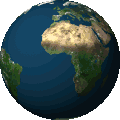|
Kingdom of Denmark
COPENHAGEN 
Denmark proper, which is the southernmost of the Scandinavian countries,
consists of a peninsula, Jutland, and an archipelago of 443 named islands, with the largest being Zealand, Funen and the North Jutlandic Island. 
Denmark lies southwest of Sweden and south of Norway, and is bordered to the south by Germany. 
Copenhagen (Danish: Kobenhavn) is the capital and largest city of Denmark. Copenhagen is situated on the islands of Zealand and Amager. 
Copenhagen Kingdom of Denmark 2008
 Originally a Viking fishing village established in the 10th century in the vicinity of what is now Gammel Strand, Copenhagen became the capital of Denmark in the early 15th century.  Beginning in the 17th century, it consolidated its position as a regional centre of power with its institutions, defences, and armed forces.  During the Renaissance the city served as the de facto capital being the seat of government of the Kalmar Union, governing the entire present day Nordic region in a personal union with Sweden and Norway ruled by the Danish monarch serving as the head of state.  Copenhagen has the two oldest amusement parks in the World. World-famous Tivoli Gardens is an amusement park and pleasure garden (I had a nice dinner there).  The historic centre of the city, Indre By or the Inner City, features many of Copenhagen's most popular monuments and attractions. The area known as Frederiksstaden, developed by Frederik V in the second half of the 18th century in the Rococo style, has the four mansions of Amalienborg, the royal residence, and the wide-domed Marble Church at its centre.  Nyhavn ( New Harbour) is a 17th-century waterfront, canal and entertainment district in Copenhagen. Stretching from Kongens Nytorv to the harbour front just south of the Royal Playhouse, it is lined by brightly coloured 17th and early 18th century townhouses and bars, cafes and restaurants. The canal harbours many historical wooden ships.  The Little Mermaid (Danish: Den lille Havfrue) is a bronze statue by Edvard Eriksen, depicting a mermaid becoming human. The sculpture is displayed on a rock by the waterside at the Langelinie promenade in Copenhagen.  Freetown Christiania, also known as Christiania (Danish: Fristaden Christiania or Staden), is an intentional community and commune.  Christiania has been a source of controversy since its creation in a squatted military area in 1971.  Its cannabis trade was tolerated by authorities until 2004. Since then, relations between Christiania and Danish authorities have been strained.  Since the beginning of the 2010s, the situation has been somewhat normalized and Danish law is now enforced in Christiania. 
Copenhagen architecture - Kingdom of Denmark
 Copenhagen is separated from Malmo, Sweden, by the strait of Oresund. The Oresund Bridge connects the two cities by rail and road.  Apart from being the national capital, Copenhagen also serves as the cultural hub of Denmark and wider Scandinavia.  Since the late 1990s, it has undergone a transformation from a modest Scandinavian capital into a metropolitan city of international appeal in the same league as Barcelona and Amsterdam. 
Copenhagen Frederiksborg castle 2008
 Frederiksborg Castle (Danish: Frederiksborg Slot) is a palatial complex in Hillerod.  It was built as a royal residence for King Christian IV of Denmark-Norway in the early 17th century, replacing an older castle acquired by Frederick II and becoming the largest Renaissance residence in Scandinavia.  Copenhagen Frederiksborg castle 2008.  Copenhagen Frederiksborg castle 2008.  On three islets in the Slotssoen (castle lake), it is adjoined by a large formal garden in the Baroque style.  Copenhagen Frederiksborg castle 2008.  Copenhagen, Kingdom of Denmark, 2008. 
Denmark
RONNE BORNHOLM june 2014 
Ronne is the largest town on the Danish island of Bornholm in the Baltic Sea. 
Owing to its natural harbour and its strategic position in the Baltic Sea, Ronne has an interesting history coming under German and Swedish influence during its development as a herring fishing port.  Today, with its cobbled streets, half-timbered houses and interesting museums, it attracts visitors mainly from Denmark, Germany, Sweden and Poland.  The town has some quaint cobbled streets and low-timbered houses.  The Ronne Lighthouse, a slender white-painted octagonal tower in cast iron, stands on the waterfront not far from the church. Constructed in 1880, it was decommissioned in 1989.  Two streets of particular interest are the Laksegade and the Storegade, which contain many historic houses which were once the homes and trade buildings of merchants and noblemen.  Ronne Bornholm june 2014.  Ronne Bornholm june 2014.  Ronne Bornholm june 2014.  Ronne Bornholm june 2014.  Ronne Bornholm, street art, june 2014.  Ronne Bornholm, june 2014.  
|















